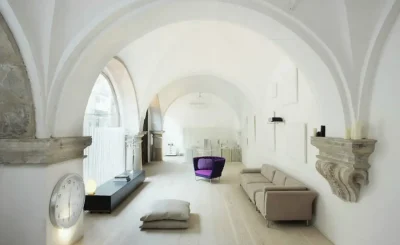And the lesson of wabi-sabi is a delightful reminder to cherish imperfection at a time when perfection is everywhere praised. Nothing matches the tranquillity that your home can provide when there is beauty in cracks or dents and the moss-covered wall, that comfortable old wooden chair.
Make an apartment feel Japanese by using natural materials such as bonsai trees and bamboo potted plants that naturally lend themselves to a cosy and mellow atmosphere due to the blending of tones from woodgrain and plant leaves.
Natural Light
Natural light spills freely into the room, fostering a harmonious relationship between our homes and the outdoors. Use skylights or full-length windows in your plans, or install sliding doors like our Yukimi Shoji to welcome more light into your home for a calm and soothing ambience.
To bring one’s furnishings and decorative pieces into the realm of Wabi Sabi, try using earthy green tones to reflect the richness of nature. This attitude of acceptance – which dwells on the inescapable fleetingness of objects as well as their inherent flaws – can also be applied to brittle china, rippling fabrics, cracked plaster and even worn paint.
Keep it neutral with grey, beige and soft green. Neutral tones are tranquil, and Japanese tones strive toward a state of ‘less’, valuing open space as one of the most exhilarating luxuries in life. In these images, the wall space is visually understated; walls are best devoid of anything ‘busy’. Our line art print of praying mantis yoga pose can be a feature on walls!
Traditional Elements
This aesthetic expression is reflected in many aspects of Japanese home decor: large windows and sliding doors designed to bring light from outside in; interior spaces generally lit by daylight; indoor plants to purify air and bring colour and texture into a room; and rock gardens (known as ‘dry landscapes’) and water features are also common.
The Japanese entrance or genkan is generally wooden and welcoming, while the sleeping space is filled with tatami mats.
Wabi-sabi does appreciate asymmetry, but the philosophy is much more about the beauty of imperfection in general. Managing to capture rough textures or uneven symmetry, or a mix of both – or perhaps a sense of understated refinement, or appreciation for natural ageing – is essential. The tokonoma is a raised alcove that is traditionally characterised as a special place for the display of art objects.
Wooden Pieces
Natural elements are used frequently in Japanese interior design as well. In many cases, furniture in a house is made from wood or bamboo; this brings warmth indoors and also reminds us that nature has not been forgotten despite how far from its seclusion we might be.
The photogenic nature of Wabi-Sabi – Japanese aesthetic design featuring visibly scratched or damaged surfaces that reveal the object’s history and add to its character – suggests that these necessary evils might not always be so.
Wooden items from Mojo Boutique will make your Japanese interior come alive. Wood has long been a sign of a simpler nature-friendly aesthetic, and the pieces can add to a Japanese interior, especially when made by local artisans that are both timeless and affirmative of local talent. Finally, one modern twist I’d like to suggest is to adapt the aesthetic to your western lifestyle by adding pieces that draw from this simple aesthetic and expose more natural components visible in your living space. An example of this would be adding a pair of shoji screens in your home setup, or perhaps tatami mats, so that your evening meals can be on the floor — the floor in full view, without any additives enhancing it, like a rug. You might also raise the serene view of suburban life, the good parts of nature (such as the Japanese garden or mountains), and keep the rest of the image unconcealed.
Neutral Tones
Colour is in part this subdued quality of warmth that permeates Japanese-inspired interior design. A simple way to achieve this mood, with a less intimidating palette than the architectural projects we’ve been showcasing, is to use warm neutrals and natural hues. You can also choose to use the furniture and furnishing elements as neutral backdrops, since the delicate and neutral, woody browns and earthy greens found in wooden elements or in nature, can let your space take centre-stage.
Choose pieces of furniture and decor with natural textures, like woven materials, rattan, or other organic textures as wabi-sabi teaches us that beauty is found in imperfection, so pieces should look lived-in and embrace the natural formation and ageing process. These pieces will eventually age gracefully and acquire new characteristics, creating an organic, timeless look.
Emphasise natural textures with earth colours such as sage green and rusty red. Blue or deeper indigo accents balanced out a scheme like this for harmony. Leonard Koren’s The Rhythm of Imperfection is an invaluable resource for Wabi-sabi aesthetic.
Soft Lighting
Given the fact that warm lighting is essential in a Japanese-inspired condo interior design aesthetic, opt for paper lanterns or diffused ceiling lighting, or even opt for bulbs with a warmer hue in order to make everything work. You will be glad that you did.











